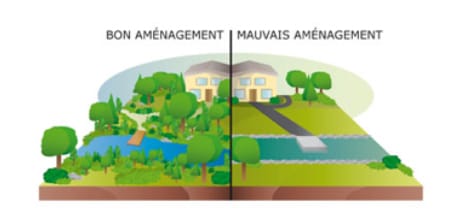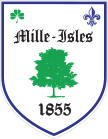* Please note that there is no public access to a lake on the Municipality’s territory.
Riparian strip
The part it plays
The Riparian Strip plays a very important part in the health of lakes and rivers. It allows it to:
- Filter pollutants or contaminants before they can enterwaterways;
- Vegetation retains the input of nutrients such as phosphorus and nitrogen, something that algae love. The vegetation also absorbs pollutants such as fertilizers and pesticides in part or entirely. We must not forget that lawns need fertilizers to stay healthy. But in rainy weather, much of the fertilizer that feeds them escapes into the waterways and contributes to the over-fertilization of the waters. Result: aquatic plants begin to proliferate excessively;
- Stops sediment input;
- Due to the root system and natural vegetation, sediments such as sand and soil are retained before being thrown into the water;
- Curbs erosion with roots;
- In rainy weather, the striking power and speed of billions of drops of water falling into a forest is slowed down by the leaves of trees and shrubs. When they reach the ground, droplets no longer have the strength to create Erosions, but in a grassy environment, it is a completely different story: water drops hit the ground with full force, thus displacing soil particles and creating numerous erosions;
- Regulate the temperature of the water;
- Vegetation is shady on water and on rocks at the edge of the water. With shade, this limits the proliferation of algae. When the riparian strip is only grass, the water temperature increases considerably);
- Fostering biological wealth;
- The riparian strip guarantees a rich habitat for wildlife, to the delight of fishermen and hunters. Fish need food to live. And insects account for a large part of their diet. Many of these insects naturally fall from the trees, shrubs or the herbaceous plants that are found on the riverbanks still in their natural state. The natural vegetation on the banks is a pantry for fish, unlike lawns that are biological deserts.
For a riparian strip to be effective and perform its roles fully, it must have a minimum width of 15 meters and be left in its natural state. This width allows a greater surface area of pollutant absorption and sediment blocking. It is therefore prohibited to control the vegetation, which includes lawn mowing, brush cutting and tree felling. NOTE: It is permissible to provide access to the body of water via a 5-meter-wide, bias-oriented path.

Authorized work

If it is ever necessary to intervene in the Riparian Strip, be aware that the Municipality must first authorize any work. We will analyze the work to be undertaken and validate whether applicable laws and what the environmental impact would be.
The works that is authorized for the riparian strip are present in section 12.3 of the Zoning By-law RU.02.2011 (french only). Also, the Municipality has a list of authorized vegetation for the riparian strip when it comes to vegetation for the property. This list is included in the zoning by-law.
Prior to the work, the Municipality must issue a permit. Contact the Planning and Environment Department for more information at 450 438-2958 ext. 2608.
Did you know that?
Grass is the most important source of environmental degradation of a lake. Even though lawns are green and very pretty, they often do more damage than toxic substances, solid waste and wastewater. It is therefore necessary to stop thinking that a lake surrounded by large areas of lawn is a “beautiful” lake.
Organisme de bassin versant - Abrinord
Who are they?
Abrinord, the rivière du Nord watershed organization, is one of 40 watershed organizations (OBV) officially recognized by the Quebec government in the Act affirming the collective nature of water resources and promoting better governance of water and associated environments. The organization is responsible for planning and coordinating integrated water management in the area entrusted to it. Founded in 2003, Abrinord is a concertation and planning table whose primary mandate is to draw up a Water Master Plan (PDE), to update it, and to promote and monitor its implementation.
Their mission
To work with the various stakeholders to implement, apply and develop integrated water management in the watersheds of the Abrinord area, in order to achieve better water protection.
Their mandates
- Develop and update a Water Master Plan (WMP)
- Prioritize and monitor implementation of the MP.
- Promote the development of integrated water management skills.

For more information, visit ABRINORD.CA.
How to form a Lake Association
A lakeside cottage is a dream of a lifetime, but these lake front properties are not always laid out to respect the environment or the regulations. The owners of these properties must therefore intervene, and, with a lake association, it is possible to have rules that are applicable to each.
In this context, a lake association is a group of volunteer residents who have a common interest in protecting the quality of the lake’s water, landscapes and uses.
Regroup!
The word explains it very well. One is good, but two is better. Alone, it is very difficult to impose rules and criteria on a group of owners. With a united group, lake association residents will be able to better express their wishes, and also regulations and information required for the survival of their lake.
What to start with
A common interest must be established by the majority of residents. A meeting is required to validate the interest and expectations of each owner. It is best to call upon an already existing Lake Association in order to know the steps to follow, the good and bad things that happened along the way. You can begin with a temporary committee which will look into the interest of setting up an association. Once the main objectives have been established, you can then send them to the other residents in the form of door-to-door delivery (the most effective), mail or e-mail, to indicate the intention of forming an association. A date must be indicated for the meeting.
The types of association
There are different legal forms for an association that citizens can choose from:
Not personified Association (not endowed with the legal person):
- Uncomplicated structure, with few members and few assets to administer;
- The rules of operation are provided in the Civil Code of Québec;
- The Directors are personally liable for the obligations of the Association as a result of decisions made during their administration.
Personified Association (with a legal person, non-profit) (the most common):
- The members of the corporation are not personally liable for the debts and liabilities of the corporation; they are only liable for payment of their membership fees;
- The corporation may make or receive donations;
- The directors of the corporation are not personally liable to third parties;
- The corporation may sue or be sued in the courts.
Remember that if a personified association is incorporated, the solemn affirmation must be signed by a person authorized to take oaths (lawyer, notary, etc.), to pay the costs and to send the application to the Registrar of Enterprises.
Then…
You must proceed to the drafting and adopting of the bylaws and the action plan, set the amount of the annual membership fee, elect the board of directors and set a date for the general meeting.
It is important to take steps to promote the lake association with the local residents as well as with various organizations and the municipality.
Do not hesitate to contact the Planning and Environment Department for additional information or to conduct online searches for various organizations.
Your Lake Associations hold an Annual General Meeting, for more information, please contact them.
Voluntary Lakes Surveillance Network
Introduced in 2004, the RSVL allows participants to get involved in protecting their lakes. Indeed, they can carry out the necessary actions themselves to assess the state of their lakes and to follow their evolution over time, while benefiting from the expertise of the Ministry and the framework that they offer. More than 500 lakes were enrolled in the Network in 2009.
Information on the Voluntary Lakes Monitoring Network and how to register is available on the Ministry’s website: site Web du Ministère (french only).
Lake Association
Anne Lake Association
President: Reid McDougall
E-mail: reidmcdougall@gmail.com
Tamaracouta Lake Association
President: Lyne Lanthier
E-mail: lanthierlyne@gmail.com
Paul Lake Association
Interim President: Diane Bourdages
E-mail: associationresidentslacpaul@gmail.com
Ivan Lake Association
President: Stéphane Goulet
E-mail: goulets@outlook.com
Becs-Scie Lake Association
President: David Nazm
E-mail: nazmdavid@gmail.com
Daïnava Lake Association
Président : Jean-françois Lacasse
E-mail: jfrançois.r.lacasse@gmail.com
Hugues Lake Association
Environment Director : Heather McCullough
E-mail: heathermcc71pp@gmail.com

